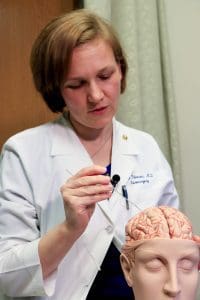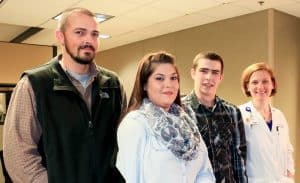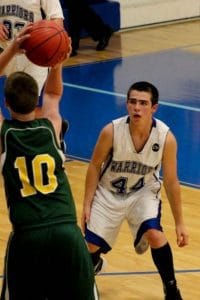Deep Brain Stimulation Surgery Lets Teen Walk and Run
| Dec. 8, 2015|“Can you believe that something this small is what has changed how well you move?” UAMS neurosurgeon Erika Petersen, M.D., said showing a wire the size of a spaghetti noodle to 15-year-old Darius Hoppis.
Before the brain surgery, Darius was hardly able to walk.

Darius Hoppis, 15, has a neurological disorder called dystonia. Thanks to deep brain stimulation surgery, he can walk again and plays basketball on his high school team.
Now Darius is a warrior — a Western Grove Warrior where he’s not only able to walk, but runs and plays post for his junior high basketball team.
Darius’ transformation came after he underwent a procedure known as deep brain stimulation, performed by Petersen, associate professor in the UAMS College of Medicine’s Department of Neurosurgery. He is the first child to receive this type of surgery at UAMS.
Darius has a neurological disorder called dystonia. His mother, Rena Hoppis, said before age 6 he was walking, talking and behaving like any other child his age.
“We first noticed the problem at a T-Ball game,” Rena Hoppis said. “He told us his foot hurt. We went and got him new cleats because we thought that was the problem.”

UAMS neurosurgeon Erika Petersen, M.D. , demonstrates how she put the electrodes into the brain during surgery.
It wasn’t long before Darius’ parents knew that the problem was not his shoes.
“He would walk fine. But when he ran, his left foot would turn inward,” Hoppis said.
They took Darius to his primary care physician, who thought he had scoliosis. Darius was referred to Arkansas Children’s Hospital. There, doctors determined he did not have scoliosis.
Four months later the movement disorder started to affect his arms and hands. Doctors did further testing and determined Darius had dystonia.
Darius began treatments including physical therapy, occupational therapy and Botox injections in his leg and arm. By this time he was wearing a leg brace and was no longer able to speak.
“Darius and his family worked a while with many types of treatments,” Petersen said. “After trying almost everything, they began to consider the idea of deep brain stimulation surgery.”
Deep brain stimulation involves surgically implanting small electrodes that are connected to a pulse generator into specific regions of the brain that control movement.
A multi-disciplinary team evaluated Darius’ condition to determine if surgery would be the best option for the then 11-year-old boy.
The team involved his neurologist Walter Metzer, M.D., professor in the UAMS College of Medicine’s Department of Neurology; Petersen; UAMS imaging experts and a neuropsychology team through the Walker Family Clinic at UAMS’ Psychiatric Research Institute.
“There’s a lot to consider when you’re talking about the risk that is encountered with surgery,” Petersen said. “Particularly when you’re talking about surgery on a child. Obviously you don’t want deep brain stimulation to be the first solution if there is something short of surgery that can be beneficial.”
“Ultimately, it was up to Darius,” his mother said. “His father and I had done a lot of research. We watched videos of the procedure and even joined a support group of people who had gone through the surgery before. But DJ had the final say.”
On Oct. 1, 2012, the family arrived in Little Rock for Darius’s procedure. It had been determined the surgery should take place at UAMS because of the equipment and expertise needed throughout the process.
“The whole key in deep brain stimulation is to know where within the brain you have to intervene,” Peterson said. “In the case of dystonia, it’s in an area where the signals are overactive. They’re telling the body to tense up or overtighten. We put in a system that acts much like a pacemaker for the brain.”
Darius’ mother could see a difference in the recovery room.
“He was able to open and shut his left hand,” she said. “He had not been able to do that for years.”
Doctors did not turn on the device permanently until one month later after Darius had recuperated from the surgery. His mother says the difference was immediately noticeable.
“He started walking a lot better. His balance was better. He wasn’t falling. He no longer needed his leg brace.”
Three years later, the Hoppis family is still seeing progress. Darius’s self-esteem has increased. He can use his hands and his speech is improving. His face lights up when he shows his doctor photos of himself on the basketball court.
“Dr. Petersen completely changed his life,” Hoppis said. “She changed all our lives.”


